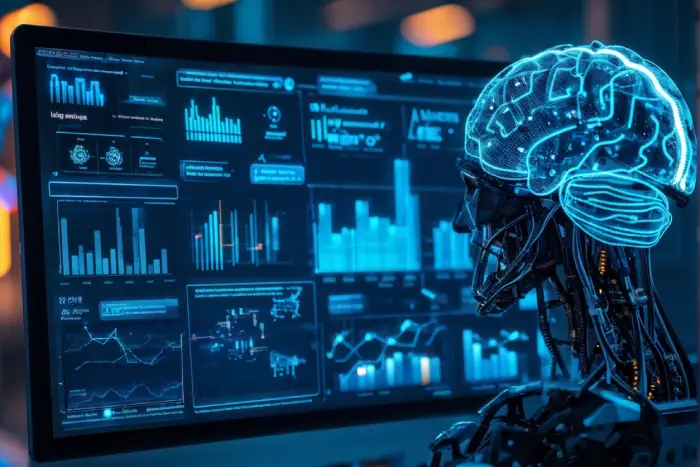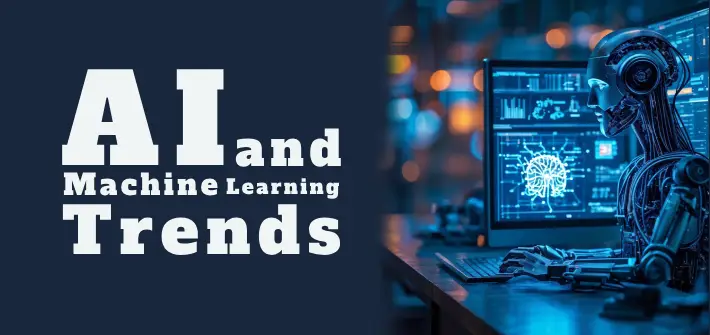artificial intelligence (AI) and machine learning (ML) are no longer just buzzwords; they are transforming industries and reshaping the future. As we progress through 2024, several AI and machine learning trends are emerging, promising to revolutionize various sectors. This article delves into these trends, highlighting key developments and their implications.
AI and ML Integration Across Industries
Healthcare
AI and ML are significantly impacting healthcare, from diagnostics to personalized treatment plans. For instance, machine learning algorithms analyze vast amounts of medical data, leading to quicker and more accurate diagnoses. Additionally, AI-powered imaging tools can detect anomalies in X-rays and MRIs with precision. Moreover, personalized medicine, which tailors treatment based on individual genetic profiles, is becoming more feasible thanks to AI advancements.
Finance
In the finance sector, AI and ML are enhancing fraud detection, risk management, and customer service. Algorithms can analyze transaction patterns to identify fraudulent activities, offering real-time alerts to prevent losses. Furthermore, AI-driven chatbots and virtual assistants are improving customer interactions by providing instant responses and personalized financial advice.
Retail
The retail industry is also benefiting from AI and ML. Personalized recommendations, inventory management, and customer service are areas where these technologies are making a difference. Consequently, retailers use machine learning models to predict consumer behavior, optimize inventory levels, and provide personalized shopping experiences.
Emerging AI and ML Trends
Explainable AI (XAI)
One of the significant challenges with AI and ML is their “black box” nature. Explainable AI aims to make these models more transparent and understandable. By providing insights into how algorithms make decisions, XAI builds trust and facilitates better decision-making. Therefore, this trend is particularly crucial in sectors like healthcare and finance, where understanding AI decisions can have critical implications.
AI Ethics and Governance
As AI becomes more pervasive, ethical considerations and governance are gaining prominence. Organizations are developing frameworks to ensure ethical AI use, focusing on fairness, accountability, and transparency. Additionally, regulations and guidelines are being established to prevent biases and ensure AI systems operate within ethical boundaries.
Edge AI
Edge AI refers to processing AI algorithms locally on devices rather than relying on cloud-based servers. This trend is driven by the need for real-time data processing and reduced latency. Edge AI is particularly relevant for applications in autonomous vehicles, IoT devices, and smart cities, where real-time decision-making is crucial.

Advancements in Machine Learning Techniques
Reinforcement Learning
Reinforcement learning, a subset of ML, is gaining traction for its ability to solve complex problems. Unlike traditional supervised learning, reinforcement learning involves training algorithms through trial and error, optimizing actions based on feedback. Consequently, this technique is being used in robotics, game development, and autonomous systems.
Federated Learning
Federated learning allows ML models to be trained across multiple decentralized devices without sharing raw data. This approach enhances data privacy and security, making it ideal for applications in healthcare and finance, where data sensitivity is paramount. By enabling collaborative learning, federated learning paves the way for robust and diverse ML models.
Natural Language Processing (NLP)
Natural Language Processing (NLP) is evolving rapidly, with significant advancements in understanding and generating human language. For example, AI models like GPT-4 are becoming more sophisticated, enabling more accurate language translation, sentiment analysis, and conversational AI. As a result, these advancements are revolutionizing customer service, content creation, and communication.
AI in Autonomous Systems
Self-Driving Cars
Autonomous vehicles are one of the most visible applications of AI and machine learning trends. Companies are investing heavily in developing self-driving cars, aiming to enhance safety and efficiency. For instance, machine learning algorithms process vast amounts of data from sensors and cameras to navigate and make real-time decisions. While fully autonomous vehicles are still in development, significant strides are being made.
Drones and Robotics
AI-powered drones and robots are being deployed in various sectors, including agriculture, logistics, and surveillance. In agriculture, drones use AI to monitor crop health and optimize irrigation. Additionally, in logistics, autonomous robots are enhancing warehouse management and delivery services. Consequently, these advancements are improving efficiency and reducing operational costs.

The Role of AI in Enhancing Cybersecurity
Threat Detection and Prevention
AI and ML are becoming integral to cybersecurity, offering advanced threat detection and prevention capabilities. For example, machine learning algorithms analyze network traffic patterns to identify anomalies and potential threats. Additionally, AI-powered security systems can respond to incidents in real-time, mitigating risks and protecting sensitive data.
Behavioral Analysis
Behavioral analysis powered by AI helps detect unusual user behavior that may indicate a security breach. By continuously monitoring and analyzing user activities, AI systems can identify and respond to threats proactively. As a result, this approach enhances security measures and reduces the risk of insider threats.
Preparing for the Future
Skill Development
As AI and ML technologies advance, the demand for skilled professionals in these fields is increasing. Continuous learning and skill development are essential to stay relevant in this dynamic landscape. Therefore, professionals should focus on acquiring expertise in data science, machine learning algorithms, and AI ethics to thrive in this evolving industry.
Collaboration and Innovation
Collaboration between academia, industry, and government is crucial for driving innovation in AI and ML. For instance, research institutions and tech companies must work together to push the boundaries of what these technologies can achieve. Additionally, regulatory bodies should create an environment that fosters innovation while ensuring ethical AI use.
Conclusion
The trends in AI and machine learning are reshaping various industries, offering unprecedented opportunities and challenges. From healthcare and finance to retail and cybersecurity, these technologies are driving innovation and transforming how we live and work. As we navigate this AI-driven future, staying informed about the latest trends and advancements is essential. Therefore, embracing ethical considerations, continuous learning, and collaboration will ensure that we harness the full potential of AI and ML, paving the way for a smarter, more efficient world.




